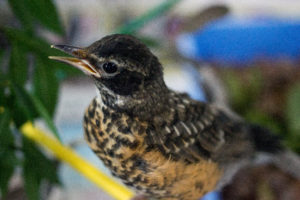Bumper Crop for Baby Care Unit
By Hospital Manager Denys Hemen

Orphaned birds like this young American robin are placed in CWC’s Baby Care Unit while they receive the treatment and diet necessary for them to grow. Photo by Kim Barker
It was another great year inside of our baby bird nursery at California Wildlife Center. We are the only wildlife rehabilitation center in Los Angeles County that takes in baby songbirds, baby crows, and baby ravens. Due to this fact, we have to dedicate lots of space to their care. We added 128 square feet of indoor space to our existing 14 enclosures that are dedicated to baby songbirds, crows, and ravens. It took our team a lot of blood, sweat, and tears to accomplish but it was well worth it.
We were able to release hundreds of birds back to the wild. There was a wide array of birds that traveled through our doors this summer. There are the most common species we care for and raised: northern mockingbirds, black phoebes, house wrens, western scrub jays, western kingbirds, cliff swallows, mourning doves, dark-eyed juncos, American robins, house finches, bushtits, acorn woodpeckers, California towhees, American crows, lesser goldfinches, and common ravens.
At the height of the season, we were ordering 60,000 mealworms, 1000 waxworms, and 2000 crickets per week to feed the songbirds and 50 pounds of dog food, protein, eggs, and produce per week for the crows and ravens! Our dedicated team of staff, interns, and volunteers worked 13-hour days to feed all of the open and hungry mouths.
Baby bird season has just ended at CWC. We put our last group of northern mockingbird babies out in the aviaries last week. It was a tough summer! But before we even take a breath, 48 baby squirrels moved into the nursery!
